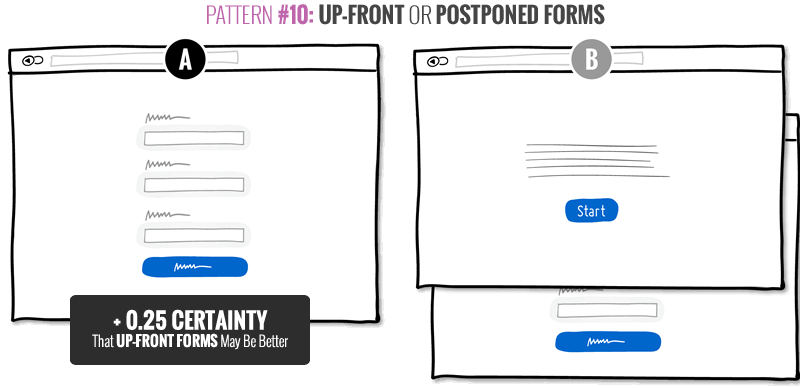Evidence #65: A Possible +4.9% To Leads From Up-front Forms
A big thanks to Justin Rondeau from DigitalMarketer.com for sharing Evidence Test #65. The key change of this experiment was a switch from a postponed form to an up-front one (or a 2 step vs 1 step). From this test we were also able to derive +0.25 certainty points favoring up-front forms (relating to Pattern #10).
What Can We Learn From This Test?
The test shows a possible increase to leads from an up-front or exposed form style, instead of a 2 step one. Because there were a handful of potentially additional changes and the effect wasn't very strong, we are able to extract a smaller +0.25 certainty score from this test in favor of up-front forms (covered in detail in Pattern #10 with additional tests).

List Of Changes & Potential Causes Of Effect
-
Upfront Forms / Single Step [Key Change]
The email form field was shown right before the call to action.
-
Use of "Spam" Copy
The control mentioned "[we] would never spam you!" which might have had an negative effect.
-
Inconsistent Fonts
The control also made use of inconsistent font styles (a handwritten font on the modal window).
-
Inconsistent Buttons & Labels
The control also had two separate button styles and labels.
 Jakub Linowski on Nov 16, 2016
Jakub Linowski on Nov 16, 2016
Comments
Dave Barnett 8 years ago ↑1↓0
I'd be curious to know how flexible or strong this pattern is. Previous studies supported an increase in conversion rates due to smaller commitments. We also know from numerous studies that lean forms which ask less of the user are more likely to succeed. Perhaps more "conventional wisdom" than data-supported, but the general feeling is that a form, presented before the user is ready, can scare them away. For the above reasons, I suspect the pattern is fairly brittle; the context and content of this pattern can easily negate the proposed benefits.
Does a form with 10 fields benefit from up-front display?
Reply
Jakub Linowski 8 years ago ↑0↓0
Hey Dave. One observation that is emerging is that if there are more fields, postponed forms tend to work (we have 3 tests like that). And in the case of single fields, they may be better off shown right away (from 2 tests). This is still something we're watching ...
Reply